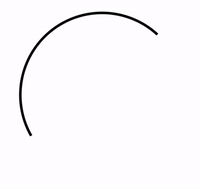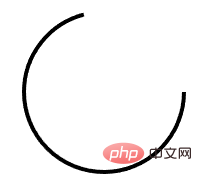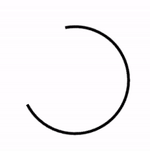 Web Front-end
Web Front-end
 CSS Tutorial
CSS Tutorial
 An article explaining in detail how to implement loading animation of dynamic arc line length changes with css
An article explaining in detail how to implement loading animation of dynamic arc line length changes with css
An article explaining in detail how to implement loading animation of dynamic arc line length changes with css
How to use CSS to implement dynamic line loading animation? The following article introduces three methods of using CSS to implement loading animations that change the length of dynamic arc lines. I hope it will be helpful to everyone!

A group of friends asked me how to use CSS to achieve the following Loading effect:

This is a very interesting one question.
We know that using CSS, we can easily achieve such an animation effect:
<div></div>
div {
width: 100px;
height: 100px;
border-radius: 50%;
border: 2px solid transparent;
border-top: 2px solid #000;
border-left: 2px solid #000;
animation: rotate 3s infinite linear;
}
@keyframes rotate {
100% {
transform: rotate(360deg);
}
}The animation is as follows:

with requirements Compared with the line loading animation, the above animation lacks a core point:
- The length of the line will change during the rotation movement
So, the difficulty here becomes, how to dynamically realize the length change of the arc segment? Solving this problem basically solves the above-mentioned line transformation Loading animation.
This article will introduce several interesting ways in CSS that may dynamically change the length of arc lines:
Method 1: Use masks to achieve
The first method The method, which is also easier to think of, is to use masking.
We implement two semicircle lines, one is the actual color that can be seen, the other is the same as the background color, a relatively thicker semicircle line, when two When the speed of line movement is inconsistent, we can visually see dynamically changing arc lines.
Look at the schematic diagram and you will understand at a glance:
<div></div>
div {
width: 200px;
height: 200px;
}
div::before {
position: absolute;
content: "";
top: 0px; left: 0px; right: 0px; bottom: 0px;
border-radius: 50%;
border: 3px solid transparent;
border-top: 3px solid #000;
border-left: 3px solid #000;
animation: rotate 3s infinite ease-out;
}
div::after {
position: absolute;
content: "";
top: -2px; left: -2px; right: -2px; bottom: -2px;
border-radius: 50%;
border: 7px solid transparent;
border-bottom: 7px solid #fff;
border-right: 7px solid #fff;
animation: rotate 4s infinite ease-in-out;
}
@keyframes rotate {
100% {
transform: rotate(0deg);
}
}
For the complete code you can hit-- CodePen Demo - Linear Loadinghttps://codepen.io/Chokcoco/pen/PvqYNJThe two biggest problems with the above solution are:
- If the background color is not a solid color, the secret will be exposed
- If It is required that the length of the line segment that can be displayed is greater than half a circle, which cannot be completed


[Web Animation] Introduction to SVG Line Animation
at Here, we only need a simple SVG tag, combined with its CSS styles stroke-dasharray and stroke-dashoffset to easily achieve the above effect : <svg class="circular" viewbox="25 25 50 50">
<circle class="path" cx="50" cy="50" r="20" fill="none" />
</svg>
.circular {
width: 100px;
height: 100px;
animation: rotate 2s linear infinite;
}
.path {
stroke-dasharray: 1, 200;
stroke-dashoffset: 0;
stroke: #000;
animation: dash 1.5s ease-in-out infinite
}
@keyframes rotate {
100% {
transform: rotate(360deg);
}
}
@keyframes dash {
0% {
stroke-dasharray: 1, 200;
stroke-dashoffset: 0;
}
50% {
stroke-dasharray: 89, 200;
stroke-dashoffset: -35px;
}
100% {
stroke-dasharray: 89, 200;
stroke-dashoffset: -124px;
}
}
- stroke
: Analogous to border-color in CSS, set the border color for svg graphics; - stroke-dasharray
: The value is an array, with no upper limit. Each number alternately represents the width of the stroke and space; - stroke-dashoffset
: dash The distance from the pattern to the start of the path.
stroke-dasharray to cut the original complete line into multiple segments. Suppose stroke-dasharray: 10, 10 represents such a graphic:

stroke-dasharray: 1, 200 in the actual code means that it is in the middle of two 1px line segments, with an interval of 200px, due to The circumference of a circle with a diameter of 40px is 40 * π ≈ 125.6px, which is less than 200, so the actual figure is as follows, there is only one point:

同理,stroke-dasharray: 89, 200 表示:

通过 animation,让线段在这两种状态之间补间变换。而 stroke-dashoffset 的作用则是将线段向前推移,配合父容器的 transform: rotate() 旋转动画,使得视觉效果,线段是在一直在向一个方向旋转。结果如下:

完整的代码你可以戳这里:CodePen Demo -- Linear loading
https://codepen.io/Chokcoco/pen/jOGQGJP?editors=1100
OK,还会有同学说了,我不想引入 SVG 标签,我只想使用纯 CSS 方案。这里,还有一种利用 CSS @property 的纯 CSS 方案。
方法三:使用 CSS @property 让 conic-gradient 动起来
这里我们需要借助 CSS @property 的能力,使得本来无法实现动画效果的角向渐变,动起来。
正常来说,渐变是无法进行动画效果的,如下所示:
<div></div>
.normal {
width: 200px;
height: 200px;
border-radius: 50%;
background: conic-gradient(yellowgreen, yellowgreen 25%, transparent 25%, transparent 100%);
transition: background 300ms;
&:hover {
background: conic-gradient(yellowgreen, yellowgreen 60%, transparent 60.1%, transparent 100%);
}
}将会得到这样一种效果,由于 conic-gradient 是不支持过渡动画的,得到的是一帧向另外一帧的直接变化:

好,使用 CSS @property 自定义变量改造一下:
@property --per {
syntax: '<percentage>';
inherits: false;
initial-value: 25%;
}
div {
background: conic-gradient(yellowgreen, yellowgreen var(--per), transparent var(--per), transparent 100%);
transition: --per 300ms linear;
&:hover {
--per: 60%;
}
}看看改造后的效果:

在这里,我们可以让渐变动态的动起来,赋予了动画的能力。
我们只需要再引入 mask,将中间部分裁切掉,即可实现上述线条 Loading 动画,伪代码如下:
<div></div>
@property --per {
syntax: "<percentage>";
inherits: false;
initial-value: 10%;
}
div {
position: relative;
width: 100px;
height: 100px;
border-radius: 50%;
animation: rotate 11s infinite ease-in-out;
&::before {
content: "";
position: absolute;
top: 0;
left: 0;
right: 0;
bottom: 0;
border-radius: 50%;
background: conic-gradient(transparent, transparent var(--per), #fa7 var(--per), #fa7);
mask: radial-gradient(transparent, transparent 47.5px, #000 48px, #000);
animation: change 3s infinite cubic-bezier(0.57, 0.29, 0.49, 0.76);
}
}
@keyframes change {
50% {
transform: rotate(270deg);
--per: 98%;
}
100% {
transform: rotate(720deg);
}
}
@keyframes rotate {
100% {
transform: rotate(360deg);
filter: hue-rotate(360deg);
}
}这里,我顺便加上了 filter: hue-rotate(),让线条在旋转的同时,颜色也跟着变化,最终效果如下,这是一个纯 CSS 解决方案:

完整的代码你可以猛击这里:Linear Loading Animation
https://codepen.io/Chokcoco/pen/ZEXmJxP?editors=1100
本方案的唯一问题在于,当前 CSS @property 的兼容性稍微不是那么乐观。当然,未来可期。
最后
简单总结一下,本文介绍了 3 种实现动态弧形线条长短变化的 Loading 动画,当然,它们各有优劣,实际使用的时候根据实际情况具体取舍。有的时候,切图也许也是更省时间的一种方式:)
好了,本文到此结束,希望本文对你有所帮助 :)
(学习视频分享:css视频教程)
The above is the detailed content of An article explaining in detail how to implement loading animation of dynamic arc line length changes with css. For more information, please follow other related articles on the PHP Chinese website!

Hot AI Tools

Undresser.AI Undress
AI-powered app for creating realistic nude photos

AI Clothes Remover
Online AI tool for removing clothes from photos.

Undress AI Tool
Undress images for free

Clothoff.io
AI clothes remover

Video Face Swap
Swap faces in any video effortlessly with our completely free AI face swap tool!

Hot Article

Hot Tools

Notepad++7.3.1
Easy-to-use and free code editor

SublimeText3 Chinese version
Chinese version, very easy to use

Zend Studio 13.0.1
Powerful PHP integrated development environment

Dreamweaver CS6
Visual web development tools

SublimeText3 Mac version
God-level code editing software (SublimeText3)

Hot Topics
 1386
1386
 52
52
 How to use bootstrap in vue
Apr 07, 2025 pm 11:33 PM
How to use bootstrap in vue
Apr 07, 2025 pm 11:33 PM
Using Bootstrap in Vue.js is divided into five steps: Install Bootstrap. Import Bootstrap in main.js. Use the Bootstrap component directly in the template. Optional: Custom style. Optional: Use plug-ins.
 The Roles of HTML, CSS, and JavaScript: Core Responsibilities
Apr 08, 2025 pm 07:05 PM
The Roles of HTML, CSS, and JavaScript: Core Responsibilities
Apr 08, 2025 pm 07:05 PM
HTML defines the web structure, CSS is responsible for style and layout, and JavaScript gives dynamic interaction. The three perform their duties in web development and jointly build a colorful website.
 How to write split lines on bootstrap
Apr 07, 2025 pm 03:12 PM
How to write split lines on bootstrap
Apr 07, 2025 pm 03:12 PM
There are two ways to create a Bootstrap split line: using the tag, which creates a horizontal split line. Use the CSS border property to create custom style split lines.
 Understanding HTML, CSS, and JavaScript: A Beginner's Guide
Apr 12, 2025 am 12:02 AM
Understanding HTML, CSS, and JavaScript: A Beginner's Guide
Apr 12, 2025 am 12:02 AM
WebdevelopmentreliesonHTML,CSS,andJavaScript:1)HTMLstructurescontent,2)CSSstylesit,and3)JavaScriptaddsinteractivity,formingthebasisofmodernwebexperiences.
 How to set up the framework for bootstrap
Apr 07, 2025 pm 03:27 PM
How to set up the framework for bootstrap
Apr 07, 2025 pm 03:27 PM
To set up the Bootstrap framework, you need to follow these steps: 1. Reference the Bootstrap file via CDN; 2. Download and host the file on your own server; 3. Include the Bootstrap file in HTML; 4. Compile Sass/Less as needed; 5. Import a custom file (optional). Once setup is complete, you can use Bootstrap's grid systems, components, and styles to create responsive websites and applications.
 How to resize bootstrap
Apr 07, 2025 pm 03:18 PM
How to resize bootstrap
Apr 07, 2025 pm 03:18 PM
To adjust the size of elements in Bootstrap, you can use the dimension class, which includes: adjusting width: .col-, .w-, .mw-adjust height: .h-, .min-h-, .max-h-
 How to insert pictures on bootstrap
Apr 07, 2025 pm 03:30 PM
How to insert pictures on bootstrap
Apr 07, 2025 pm 03:30 PM
There are several ways to insert images in Bootstrap: insert images directly, using the HTML img tag. With the Bootstrap image component, you can provide responsive images and more styles. Set the image size, use the img-fluid class to make the image adaptable. Set the border, using the img-bordered class. Set the rounded corners and use the img-rounded class. Set the shadow, use the shadow class. Resize and position the image, using CSS style. Using the background image, use the background-image CSS property.
 How to use bootstrap button
Apr 07, 2025 pm 03:09 PM
How to use bootstrap button
Apr 07, 2025 pm 03:09 PM
How to use the Bootstrap button? Introduce Bootstrap CSS to create button elements and add Bootstrap button class to add button text



